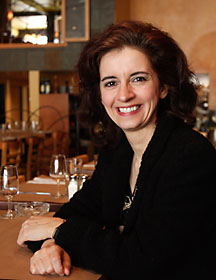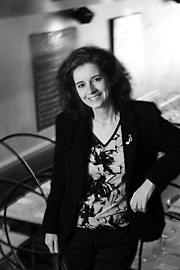Lorraine Desmarais: Big Band, Big Time: Three Takes on a Jazz Original by Marc Chénard
/ April 9, 2005
Version française...
Take One: The interview
 Lorraine
Desmarais, a musician whose reputation has long been securely established, is
now a veritable icon on the Quebec jazz scene. Although trained as a classical
pianist, she began dipping into pop music early on, in the years before her
breakthrough first prize win at the Montreal International Jazz Festival's
annual competition in 1984. She has gone on to win Juno and Félix awards for
her recordings, as well as the jazz festival's 2002 Oscar Peterson Prize (named
for the brightest star in the Canadian jazz firmament with whom,
coincidentally, she shares her August 15 birthday). Lorraine
Desmarais, a musician whose reputation has long been securely established, is
now a veritable icon on the Quebec jazz scene. Although trained as a classical
pianist, she began dipping into pop music early on, in the years before her
breakthrough first prize win at the Montreal International Jazz Festival's
annual competition in 1984. She has gone on to win Juno and Félix awards for
her recordings, as well as the jazz festival's 2002 Oscar Peterson Prize (named
for the brightest star in the Canadian jazz firmament with whom,
coincidentally, she shares her August 15 birthday).
The year 2004 was certainly one of the most satisfying
of Desmarais's career. In March of that year she headlined the "Elles Jazzent"
show, along with four other Canadian women jazz artists, which was awarded the
Opus Prize for jazz and world music concert of the year. Seven months prior,
during the Montreal International Jazz Festival's twenty-fifth anniversary, she
experienced a career highlight when she shared the stage with her "idol" Chick
Corea. Her eyes still sparkle as she fondly remembers the moment, and the
musician for whom she has great admiration.
Like all great artists, Desmarais keeps taking on new
challenges. She's currently she's been involved in forming her own big band --
her most ambitious undertaking to date. The sixteen-musician ensemble, which
brings together the cream of the local jazz scene, will début in April. The
program features twelve compositions composed and arranged by Desmarais, four
of them premieres. We met her on a blustery March afternoon to discuss her
work.
Playing with a big band is "nothing new," she said.
What is new is the combination of composing and arranging. "In 1998 I toured
the American Midwest with Diva, an all-female band with whom I recorded an
album for Arbors Jazz. Although I was only a performer at the time, the idea
was planted in my head: I had to put together my own big band." This conviction
solidified after playing a Latin music concert with the Montreal Jazz Big Band
(as invited guest soloist), and performing with trombonist Hugh Fraser's
Vancouver Ensemble of Jazz Improvisation at the annual conference of the
International Association for Jazz Educators in Toronto, in 2002.
Desmarais took advantage of a yearlong sabbatical from
her teaching job to plunge heart and soul into her big band project, which
gives its premiere performance at Montréal's Nouveau Club Soda on April 14.
Writing for a large band isn't easy. "Before starting
out, I listened to a lot of recordings -- not too many, but just enough -- and
I was especially attracted by the wonderful work of people like Bob Brookmeyer
and Maria Schneider," Desmarais explains. She hastens to add, "I also consulted
two of the greatest connoisseurs in the field: local hero Vic Vogel, of course,
but also Richard Ferland of the Université de Montréal, who is an expert when
it comes to the technicalities of arranging."
 While
composing-arranging is demanding, Desmarais found that it also helps one
experience the music from different perspectives: "During the final months, for
example, I learned how important breathing is. I can play without stopping, but
one can't write overly long phrases for a trumpeter or a trombonist, otherwise
you burn them out before concert's end. Basically, I learned something about
the importance of economy." While
composing-arranging is demanding, Desmarais found that it also helps one
experience the music from different perspectives: "During the final months, for
example, I learned how important breathing is. I can play without stopping, but
one can't write overly long phrases for a trumpeter or a trombonist, otherwise
you burn them out before concert's end. Basically, I learned something about
the importance of economy."
While piano practise has had to take a back seat
during her period of deep composing, Desmarais assures us it is not for long.
In fact, in the week following the April premiere she will journey to Europe,
where she will be performing as soloist with the Symphony Orchestra of Spain.
She'll play one of her own pieces, Love, taken from her most recent and
eponymous CD, as well as Gershwin's famous Rhapsody in Blue, one of her
all-time favourite rep pieces.
Although Desmarais is a jazzwoman through and through,
she also appreciates working with classical musicians, both in symphony
orchestras and chamber ensembles alike. Such was the case of her previous
recording "Blue Silence," in which she and her long-time band mates, bassist
Frédéric Alarie and drummer Camil Belisle, were accompanied by four wind
players from the Montreal Symphony Orchestra. This combination posed no problem
to her: indeed, one need only assess the relative strengths of the jazzers and
their classical counterparts, and then use them to their full potential. She
finds it is enough to have mutual recognition among players of the qualities of
the instruments, and for these to be used to their full potential.
After her Spanish trip, Desmarais will perform in
Maestra, an event described as "the first international meeting of women
musical creators." On May 7 she'll share the stage of Montreal's Spectrum with
American pianist Joanne Brackeen. These superlative keyboardists have played
together on one other occasion, during a past edition of the Montreal
International Jazz Festival. This year they will present a historical panorama
of women in jazz, with pieces ranging from Mary Lou Williams to originals of
their own. Desmarais the composer will be featured as well, with her
jazz-tinged sonata for flute and piano performed by Lise Daoust and Louise
Bessette.
When this article hits the stands Desmarais and her
big band will be hard at work rehearsing. Interestingly, she has not issued a
recording in the last three years (and she admits being on "back order" in this
respect), which may lead one to wonder whether this concert will serve as a
springboard for her next CD. Yet, for time being, she is not ready to a make a
commitment to retry, preferring to see (and especially to hear) the results
first. Whether her big band outing signals an on-going pursuit or a
one-shot-deal remains to be seen. Yet, whatever the outcome may be, Desmarais
is confident about one thing: "I know I've found my own voice in this medium,
and for those who will be there, I can tell them that they will recognise that
it is indeed Lorraine."
Take Two: The Blindfold Test
 Lorraine
Desmarais agreed to take the following test: five pieces performed by big bands
of different eras were given to her on a CD-R, with no information about the
tracks chosen. Her answers were sent via email. Items 3, 4, and 5 form a short
suite and only count as one selection. The musical selections: Lorraine
Desmarais agreed to take the following test: five pieces performed by big bands
of different eras were given to her on a CD-R, with no information about the
tracks chosen. Her answers were sent via email. Items 3, 4, and 5 form a short
suite and only count as one selection. The musical selections:
1. Duke Ellington: Amad (1964); Far East Suite (RCA
Bluebird).
2. Carla Bley: Walking Battery Woman (1980); Selected
Recordings (ECM)
3. 4. 5. Bob Graettinger: City of Glass (1947
version). Ebony Band, Gunther Schuller conductor (1991) (Channel Classics).
6. Barry Guy (Barry Guy New Orchestra): Tableau IV
(1998); Inscape-Tableaux (Intakt). Soloists: Barry Guy, bass, and Marilyn
Crispell, piano.
7. Jean Derome: Vancouver Vamp (2000); Rub Harder
(VICTO); Hard Rubber Orchestra of Vancouver, John Korsrud, conductor; soloist:
Ross Taggart.
Take Three: Responses
1. "The unmistakable swing arrangement of the
saxophones is reminiscent of Ellington's 'Jungle' style. Freed from the
constraints of chording, the orchestral flow is underpinned by a pedal tone
throughout. This ostinato, punctuated by a solid rhythm section accompaniment,
gives the piece a modalflavour that puts the listener in a trance-like state,
perhaps reminiscent of jazz's African origins."
2. "A swinging fanfare-like theme backed by a rhythm
section, in which the dominant arrangement heralds a bluesy Hammond B-3 solo.
Trumpet, sax, and trombone then follow with frenetic improvisations, with the
rest of the band burning its way through various rhythms, all of which leads
back to a recap of the opening theme."
3. 4. 5. "What a contrast! We're swept into an
orchestral world of symphonic dimensions -- full of highly dissonant chords and
counter-rhythms to boot. The strings make the most of their potential, with
eloquent lyricism alternating with bursts of subtle pizzicatos. The second
piece is notable for its American jazz sound accompanied by European
polytonality, out of which springs a short swing-like passage. The last
movement features exotic rhythms and percussive Latin-American colouring,
developing in a subtly modern harmonic atmosphere imbued by the spirit of jazz,
especially when the big band erupts into a brilliant and majestic swing section
that blows the listener away."
6. "This piece features an intense running dialogue
produced by a very close musical relationship within a conventional piano trio
setting. Delicate cymbal work, cool but very expressive piano, and some lyrical
bass-playing that dovetails into a solo with dramatic plucking of the
strings... a kind of prelude to an orchestral requiem, with brass, bowed bass,
and the shadowy clash of cymbals bringing this poetic excursion to a final
peaceful conclusion."
7. "Very swinging piece this is. Throughout, there is
a tenor sax solo, very modern in tone, that emerges within some very ingenious
and highly effective arranging. As the piece unfolds over a single chord, there
is a growing meditative and almost obsessive nature to it, further underscored
by the entries of trumpet and strings, which are in perfect symbiosis with the
band."
[Translated by Jane Brierley]
Version française... | 

